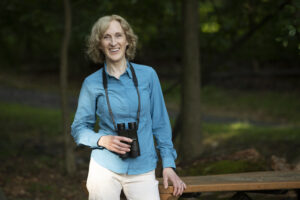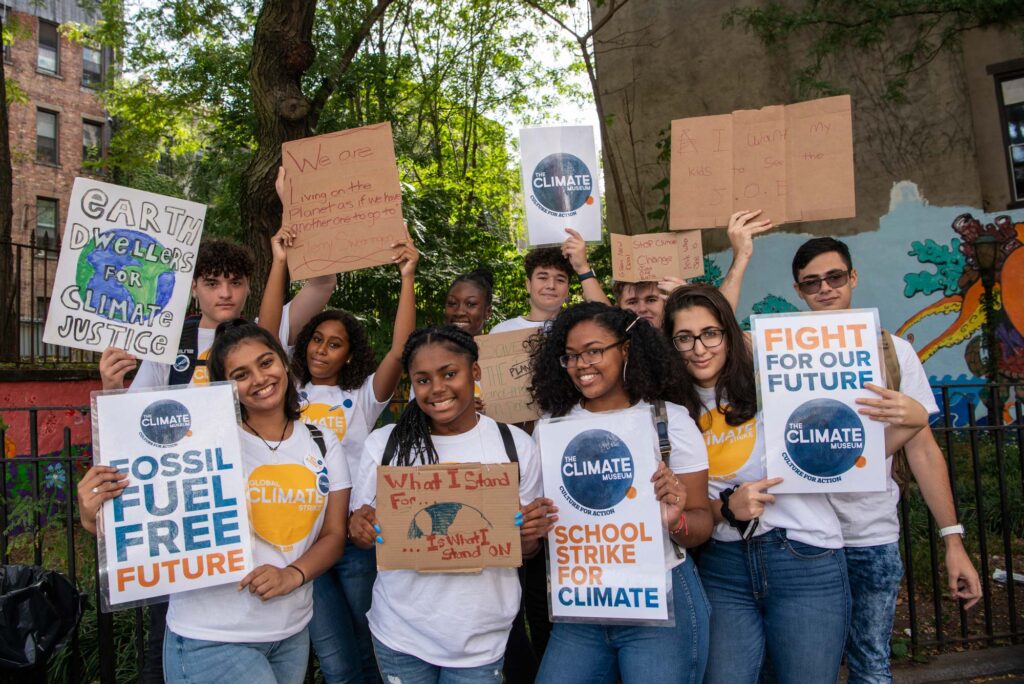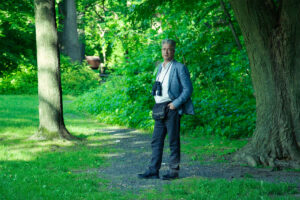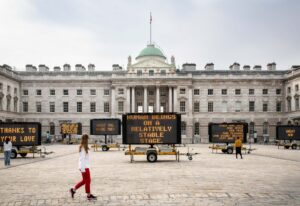
Dr. Elizabeth Gray – CEO of The National Audubon Society
Trained as a scientist and ornithologist, Dr. Gray is the first woman to hold the title of CEO in the organization’s 117-year history.
USA
Eva Baron November 17, 2021
A lifelong commitment to activism and education led Miranda Massie to become the Director of the Climate Museum in New York City. The organization’s mission is to inspire action on the climate crisis facing the globe through programming across the arts and sciences. The museum invites visitors into an active conversation about climate change, educating them on this growing problem, as well as helping them explore pathways to a better, brighter future.
Mood of Living: Where are you from? Where did you grow up?
Miranda Massie: Brooklyn and the Hudson Valley.
MoL: Where did you go to school, and what did you study?
MM: I studied American social and cultural history at Cornell University. This drew me into a continuing focus on the deep, pernicious dynamics of American inequality and how to address it. I considered pursuing these questions academically and enrolled in a doctoral program in history at Yale with a focus on 19th-century Black history and Reconstruction in particular. But after receiving my Master’s degree, I recognized that I felt too extroverted for the archives and too activist for most university settings. Eager to mobilize the privileges and advantages I had to advance broader social benefit, I enrolled in law school at NYU and interned at a range of civil rights and social justice legal nonprofits during my studies.
Although the academy wasn’t right for me as a whole, its intellectualism has always remained deeply attractive. One of the things I’ve loved about the museum world is that it combines that intellectualism with a strong orientation towards public communication, engagement and education.
MoL: Before founding and serving as the Director of the Climate Museum, you worked as a civil rights impact litigator. How did this career influence your understanding of the climate crisis and ethical engagement? How did your career in law translate into the artistic and environmental spheres?
MM: I became aware of the climate crisis as a crisis of inequality because of my background in the study of civil rights in the United States and the practice of social justice law. Simultaneously, I saw it as a problem for humanity transcending all others. For reasons I’ve touched on above, ethical engagement and an emphasis on community benefit have been compelling to me in a viscerally rewarding way — not as a sacrifice made, but as a gift received.
As a lawyer, I worked in close conjunction with activist organizations and movements, and that orientation has strongly shaped my work at the Climate Museum. Creating space for a civic community to develop is an essential component of the museum’s work.
My legal training and career have strongly informed the organizational development and governance of the Climate Museum, but have not had much to do with its aesthetic sensibilities and directions. What I bring to our aesthetics emerges more from my upbringing as the child of two freelance artists in a milieu of creatives. In my childhood, I was surrounded by both conscious and implicit attention to aesthetics, and asserted with impatience when asked by adults that, clearly, I would be an artist when I grew up! As my lack of artistic talent asserted itself even more forcefully over time, I adjusted to having a different relationship with the arts.
MoL: What compelled you to found an institution centered around climate change?
MM: Around the time of “An Inconvenient Truth,” I started to become aware of the climate crisis as the defining challenge facing humanity. Like many people who start to see climate as the essential question, I suppressed the recognition for a long time before acting on it. I wasn’t sure how I could contribute, or even how to grapple with such an all-encompassing global crisis. But my worries grew sharper and I increasingly had the sense that I wasn’t directing my energies correctly. Eventually, aided in part by personal experience of Hurricane Sandy, the pull of working on the climate became undeniable.
In more specific terms, the idea for a museum dedicated to the climate popped into my mind unbidden and I assumed that I had read about such a museum and was half-remembering what I had read. I was amazed to learn that there was no such institution in the United States and only one in the world in the outskirts of Hong Kong.
So, in 2014, I left my job, liquidated my modest, social-justice-lawyer retirement accounts and moved into a donated office space with a whiteboard and a wonderful high school intern who is currently heading to grad school.
This enormously demanding and stressful job has been by far the most rewarding contribution I feel I’ve been able to make in a very rewarding professional life. As someone who suppressed the impulse to act on the climate crisis for more than six years, I invite everyone reading this who worries about the climate crisis and feels guilty about not acting on it to not feel guilty. There is always a lag time between climate awareness and climate action. In fact, now is the time when your actions can make the most difference. Start by having climate conversations with people in your lives and calling your elected representatives. Experts identify these actions as profoundly significant for the range of futures humanity can envision.

MoL: What principles inform the exhibitions and mission of the Climate Museum? How do you hope to activate and educate the public through the Climate Museum and its creative Interventions?
MM: The Climate Museum has several key principles.
First, sixty percent of adults in the U.S. are potential climate protagonists — both worried about the climate crisis and not yet active on it. Mobilizing people in this enormous demographic to take steps toward climate action and community-building is the single most important thing we do.
Secondly, this sense of community should be seen through the lens of revitalizing a true commons, accessible to all.
Next, interdisciplinary arts programming is fundamental to providing people with pathways into climate engagement because of the intensely communal nature of the arts in human culture. Climate arts create a sense of connection, which fosters the very community we seek to build.
Finally, the climate crisis and the crisis of inequality are completely bound up with each other. The commons we are helping to revitalize must be based on principles of equity and inclusion.
MoL: Since its founding, the Climate Museum has staged a wide variety of exhibitions and projects. Have any been particularly meaningful to you? Are there any exciting upcoming exhibitions that you’d like to share?
MM: I’ll highlight two ongoing projects.
First, since before the pandemic, we’ve been working with the sculptor and installation artist Gabriela Salazar on a beautiful piece, “Low Relief for High Water.” This piece is about the idea of home in the climate emergency — the longing for a permanent home and the pervasive jeopardy that now overshadows that yearning. We’ve been making a film about “Low Relief,” and have featured programming including an in-progress short and a discussion program with Gabriela, filmmaker Micah Fink and special guest Una Chaudhuri about the intersection between the project and the pandemic available on our YouTube page.
More recently, we’ve launched a citywide poster campaign, Beyond Lies, in collaboration with the celebrated data journalist and illustrator Mona Chalabi. Mona’s posters address fossil fuel disinformation in an attempt to build media literacy and inoculate the public against deceptive advertising claims. The campaign features two calls to action: using the posters to raise awareness in different communities and calling elected representatives to weigh in on the importance of climate policy that serves our interests, not those of the fossil fuel industry. A corps of trained youth ambassadors is leading key aspects of the campaign, which also includes a website with videos from fossil fuel media experts, further reading and resources, downloadable posters, a gallery for uploading posters seen out in the world and more.
MoL: What does community and ethical engagement mean to you?
MM: Elaborating on some points sketched above, to address the climate crisis effectively we need to rebuild a genuine commons in the United States and beyond — spaces of public trust and connection with universal access. Our connections with each other are the strongest resources we have in confronting our planetary emergency. To build these connections and a robust consensus for progress, we need to confront and remediate the role of racial hierarchy and white supremacy in American society. It’s only on the basis of equity and inclusion that we can move forward on any of the challenges we confront, from the jeopardy posed to formal democracy to the climate crisis.
For those interested in reading about racism and the American commons, I highly recommend Heather McGhee’s book, The Sum of Us.
MoL: The Climate Museum is located in the heart of New York City. How do you, as founder and director, envision the Climate Museum in the broader context of New York City?
MM: New York City is one of the world’s great cultural centers. It is marked by a high level of vulnerability to sea-level rise and other impacts of climate change, by an extraordinary international and cosmopolitan diversity and by stark inequalities. All of these characteristics — cultural leadership, climate jeopardy, social dynamism and social inequality — make it a critical location for this initiative, which will take advantage of New York City’s leadership and dynamism and seek to address its risk and its inequities.
Because so many visitors come to New York City, it’s a great location for an organization with a mission centered on education and public engagement, as well.
With all that said, we believe there should be a climate-focused museum in every city geared toward taking advantage of local opportunities and addressing local concerns as a trusted voice. We also believe that the trend of museums across the spectrum of subject matter addressing the climate crisis and more in their work is extraordinarily positive. We strongly support both the dedicated institutions and the integration of climate subjects into museums with other defining missions.
MoL: How do you integrate social responsibility and eco-consciousness throughout your work and personal life? What can others do to lead more sustainable and ethically engaged lives?
MM: In my personal life, I make efforts toward sustainability in a conscious way. I live in a city with good mass transit, and while I haven’t sworn off flying, have come to view flying more through the lens of climate change and avoided taking trips on that basis.
But crucially, individual consumer choice is not central to my thinking on this question. In fact, the very term carbon footprint was coined by the oil company BP in 2004 to shift perceived responsibility from the fossil fuel industry to individual consumers. This has resulted in many people feeling, understandably, guilty and complicit in a manner that shuts us down and even blocks dialogue and action. The initiative mentioned above, Beyond Lies, includes a central focus on this very question.
We all need to continue making changes in how we live day-to-day. But the critical thing to recognize is that our power to address climate change does not begin and end in our consumer choices. It’s the civic choices we make as a community that will move us forward at large. This is one of the central guiding philosophies of our programming at the Climate Museum. We have found that the climate-worried but not-yet-mobilized members of the public, who are our core audience, respond to this message with a profound sense of empowerment and resolve. It doesn’t mean you stop recycling. It means you also talk to your neighbor about the crisis and give your member of Congress a call. These are actions recommended by experts, in addition to being actions that will make you feel great.
MoL: How has COVID-19 impacted your work with the Climate Museum? Has the pandemic changed your relationship with education, the environment and art?
MM: There are enormous lessons for all of us to learn from COVID. In some ways, humans have risen to the challenge beautifully, but there are also grounds for profound distress and anger at the scale of unnecessary losses. The central teaching of COVID is captured in a beautiful remark by the civil rights activist Bayard Rustin, who organized the 1963 March on Washington, which gave us modern civil rights laws and concepts. He said, “We are all one — and if we don’t know it, we will learn it the hard way.”
Centering the importance of equity in how we address profound human crises is an essential component of what we must carry forward.
On a more mundane but still important level, as an organization we started to learn how to use online mechanisms and tools to provide people with the sense of connection and community that we all need to tackle the climate crisis.
MoL: What advice can you give to the next generation of artists, educators, and climate activists committed to sustainability and social justice?
MM: At this moment, it is the next generation that’s providing my generation with the advice we most need: we cannot continue to abide by the norms and business-as-usual mentality that have brought us to this terrible place of jeopardy. We need a profound restructuring and revitalization of our society in order to move forward together. The youngest advocates among us, who are least socialized to the status quo, have the most to teach us on the important questions. That’s not to say that intergenerational exchange and collaboration aren’t critical; wisdom and experience have an important role to play. But disinvestment from the practices and mindsets that have created the climate crisis is the single most important thing that we all need to learn.
I invite everyone reading this to join in civic action on the climate crisis, through our current arts and advocacy campaign at beyondlies.org or in whatever way best suits you. Our worries and grief about planetary jeopardy cannot be cured — their legitimacy is indisputable. But in community and in action, they can be remediated so we can move forward together.
Photography courtesy of Miranda Massie

Trained as a scientist and ornithologist, Dr. Gray is the first woman to hold the title of CEO in the organization’s 117-year history.

Steven Peck is dedicated to creating greener, healthier & resilient cities with nature & urban agriculture.

Environmental artist Justin Brice encourages others to take a critical look at the relationship between humans and the planet.